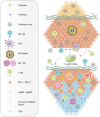Oncolytic virotherapy and tumor microenvironment modulation
- PMID: 40685482
- PMCID: PMC12277230
- DOI: 10.1007/s10238-025-01691-2
Oncolytic virotherapy and tumor microenvironment modulation
Abstract
Oncolytic viruses (OVs) have emerged as a transformative approach in cancer therapy, offering tumor-specific lysis while sparing normal tissues. In addition to their direct cytolytic effects, OVs actively reshape the tumor microenvironment (TME) by enhancing immune infiltration, disrupting immunosuppressive signals, and promoting tumor antigen presentation. However, the complexity of the TME poses challenges, often necessitating combination therapies to improve OV efficacy and overcome tumor resistance. This review explores the evolution of oncolytic virotherapy, from the early use of naturally occurring viruses to the development of genetically engineered OVs. Among the most significant advancements, T-VEC, an FDA-approved herpesvirus, has been modified to express GM-CSF, enhancing immune activation in metastatic melanoma. Similarly, JX-594, a vaccinia virus, has been engineered for selective replication in tumor cells, demonstrating the potential of OVs to combine direct oncolysis with immune modulation. Other HSV-based OVs, such as HF10 and HSV1716, further highlight the ability of OVs to enhance immune cell infiltration and increase antigen presentation within the TME. Recent advances in tumor microenvironment remodeling have expanded OV therapeutic strategies. By converting immunologically "cold" tumors into "hot" tumors, OVs can overcome immune evasion through mechanisms such as enhanced antigen release, immune checkpoint inhibition, and metabolic reprogramming. To maximize therapeutic potential, researchers are developing genetically engineered OVs carrying immune-stimulatory transgenes, exploring synergistic combination therapies with immune checkpoint inhibitors, and utilizing nanoparticle-based delivery systems for improved precision. Additionally, novel OVs-including measles virus, Newcastle virus, Zika virus, and SARS-CoV-2-are being investigated for their unique ability to disrupt the TME and enhance anti-tumor immunity. Looking ahead, OV therapy will depend on optimizing TME-targeted strategies, improving viral delivery mechanisms, and identifying predictive biomarkers to personalize patient responses. Advances in viral engineering and immunomodulation hold the potential to revolutionize cancer treatment, offering more precise and effective therapeutic options. This review provides a comprehensive analysis of current progress in oncolytic virotherapy, emphasizing its potential to remodel the TME and improve clinical outcomes.
Keywords: Cold tumor; Hot tumor; Oncolytic virotherapy; Tumor microenvironment; Virus.
© 2025. The Author(s).
Conflict of interest statement
Declarations. Competing interests: The authors declare no competing interests.
Figures


References
-
- Lawler SE, Speranza M-C, Cho C-F, Chiocca EA. Oncolytic viruses in cancer treatment: a review. JAMA Oncol. 2017;3:841–9. - PubMed
Publication types
MeSH terms
LinkOut - more resources
Full Text Sources
Medical
Miscellaneous

